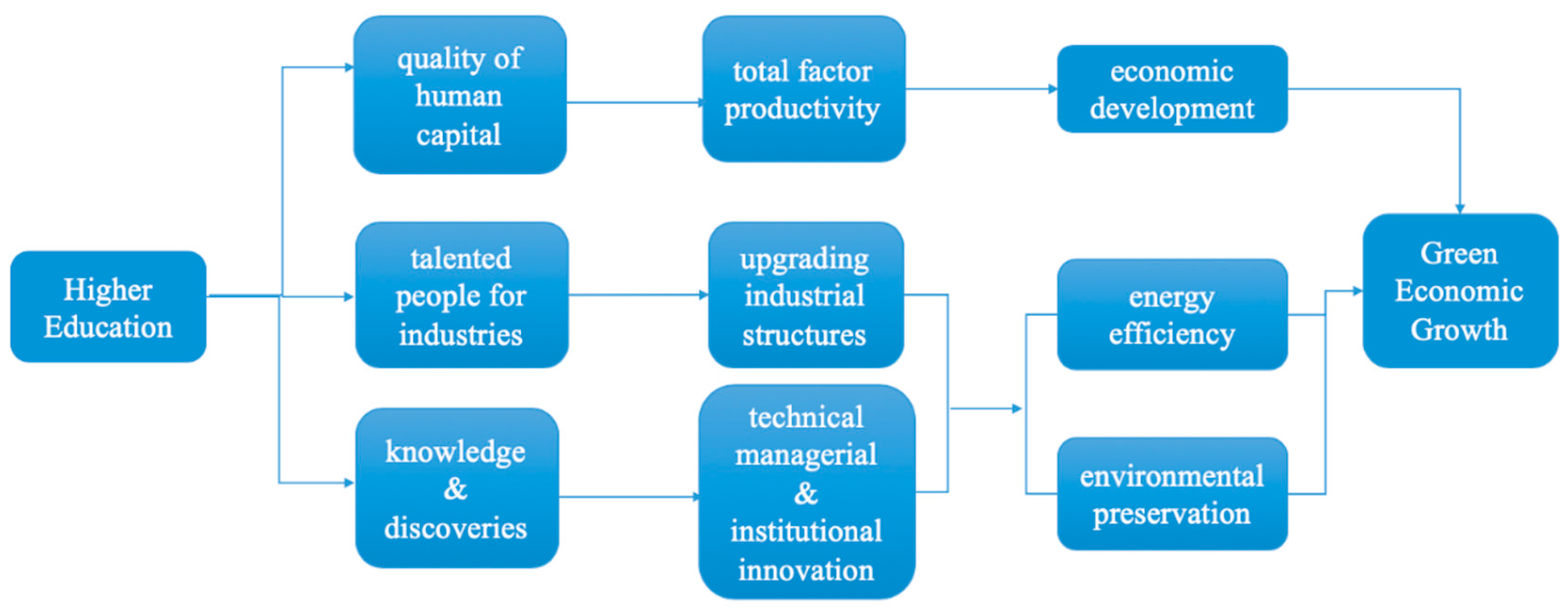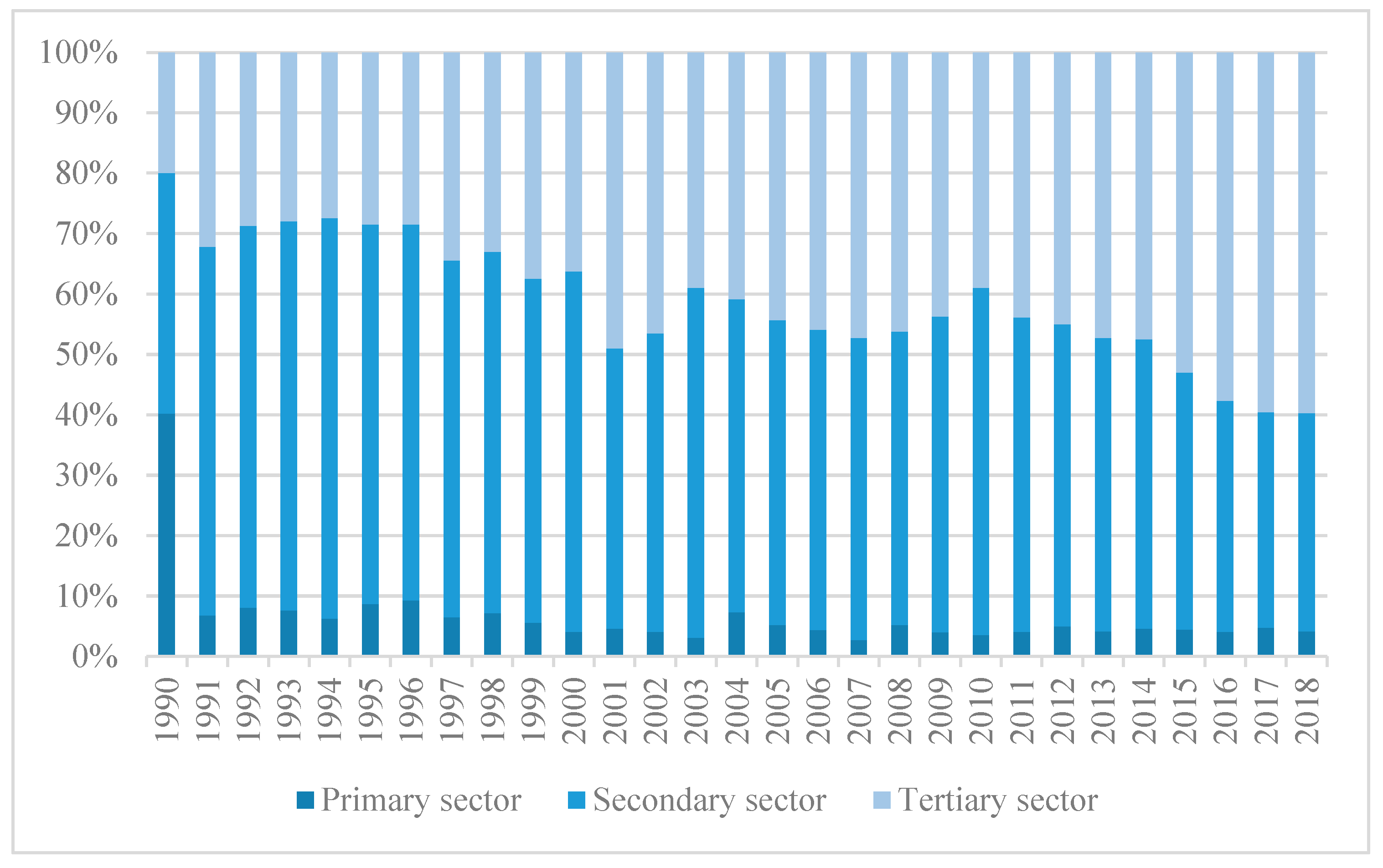An Empirical Study of the Role of Higher Education in Building a Green Economy
Abstract
:1. Introduction
2. Literature Review
2.1. Economic Growth Model
2.2. Impact of Higher Education on Economic Growth
2.3. Research Gaps
2.3.1. Limitations of Traditional GDP as a Measure of Economic Growth
2.3.2. Difficulties in Measuring Green GDP in Empirical Analysis
3. Research Design
3.1. Hypotheses
3.2. Green GDP Calculation
3.3. Modified Solow–Swan Model with Higher Education
3.4. Modelling the Impact of Higher Education on Green GDP
4. Data and Empirical Results
4.1. Data Description
4.2. Comparison of Green GDP across Countries
4.3. The Role of Higher Education to Green GDP
5. Discussion
5.1. Possible Mechanisms of Higher Education on Green Economic Development
5.2. Implications for Sustainable Development: Taking China as An Example
6. Conclusions
Author Contributions
Funding
Acknowledgments
Conflicts of Interest
References
- Schultz, T.W. Education and Economic Growth. In Social Forces Influencing American Education; Henry, N.B., Ed.; University of Chicago Press: Chicago, IL, USA, 1961; pp. 85–90. [Google Scholar]
- Barro, R.J.; Lee, J.W. Sources of economic growth. In Proceedings of the Carnegie-Rochester Conference Series on Public Policy, North-Holland, The Netherlands, June 1994; Volume 40, pp. 1–46. [Google Scholar]
- Mankiw, N.G.; Romer, D.; Weil, D.N. A Contribution to the Empirics of Economic Growth. Q. J. Econ. 1992, 107, 407–437. [Google Scholar] [CrossRef]
- Yang, D.G. Higher Education; Higher Education Press: Beijing, China, 2009; pp. 63–67. [Google Scholar]
- Stone, R. Nobel Memorial Lecture 1984: The Accounts of Society. J. Appl. Econom. 1986, 1, 5–28. [Google Scholar] [CrossRef]
- Solow, R.M. A contribution to the theory of economic growth. Q. J. Econ. 1956, 70, 65–94. [Google Scholar] [CrossRef]
- Barro, R.J.; Sala-i-Martin, X. Economic Growth; The MIT Press: Cambridge, MA, USA, 2004; pp. 23–26. [Google Scholar]
- Lucas, R.E., Jr. On the mechanics of economic development. J. Monet. Econ. 1988, 22, 3–42. [Google Scholar] [CrossRef]
- Kyriacou, G.A. Level and Growth Effects of Human Capital: A Cross-Country Study of the Convergence Hypothesis; No. 91-26; C.V. Starr Center for Applied Economics, New York University: New York, NY, USA, 1991. [Google Scholar]
- Yang, J.F.; Gong, L.T.; Zhang, Q.H. The Formation of human capital and its impact on economic growth: An endogenous growth model including education and health input. Manag. World 2006, 5, 10-18+34. [Google Scholar]
- Wang, X.L.; Fan, G.; Liu, P. The transformation of China’s economic growth mode and the sustainability of growth. Econ. Res. 2009, 44, 4–16. [Google Scholar]
- Keller, K.R. Investment in primary, secondary, and higher education and the effects on economic growth. Contemp. Econ. Policy 2006, 24, 18–34. [Google Scholar] [CrossRef]
- Yue, C.J. International comparison of higher education and economic development in the 40 years of Reform and Opening Up. Educ. Econ. 2018, 6, 9–17. [Google Scholar]
- Gyimah-Brempong, K.; Paddison, O.; Mitiku, W. Higher education and economic growth in Africa. J. Dev. Stud. 2006, 42, 509–529. [Google Scholar] [CrossRef]
- Lin, T.C. The role of higher education in economic development: An empirical study of Taiwan case. J. Asian Econ. 2004, 15, 355–371. [Google Scholar] [CrossRef]
- Song, H.M.; Wang, R. Measurement and Analysis of Higher education’s contribution to economic growth. J. High. Eng. Educ. Res. 2005, 1, 55–58. [Google Scholar]
- Kuznets, S.; Epstein, L.; Jenks, E. National Income and Its Composition, 1919-1938; National Bureau of Economic Research: New York, NY, USA, 1941; Volume 1, pp. 1–25. [Google Scholar]
- Yao, Y. The Chinese Growth Miracle. Handb. Econ. Growth 2014, 7, 943–956. [Google Scholar]
- The State Council of the People’s Republic of China. Report on the Work of Chinese Government. 2018. Available online: http://english.www.gov.cn/premier/speeches/2019/03/16/content_281476565265580.htm (accessed on 17 September 2019).
- An, L.B.; Xiao, Y.Q. Green development and Institution: Interpretation of GGDP. Stat. Decis. 2005, 1, 52–53. [Google Scholar]
- Xiang, S.J.; Zheng, R.K. Research on China’s Green Economy Development Index. Stat. Res. 2013, 30, 72–77. [Google Scholar]
- Ding, X.H. Comments on the World Bank’s new method of estimating national wealth and human resources. Econ. Sci. 1997, 4, 68–74. [Google Scholar]
- Boyd, J. Nonmarket benefits of nature: What should be counted in green GDP? Ecol. Econ. 2007, 61, 716–723. [Google Scholar] [CrossRef]
- Li, G.; Fang, C. Global mapping and estimation of ecosystem services values and gross domestic product: A spatially explicit integration of national ‘green GDP’ accounting. Ecol. Indic. 2014, 46, 293–314. [Google Scholar] [CrossRef]
- Hamilton, C. The genuine progress indicator methodological developments and results from Australia. Ecol. Econ. 1999, 30, 13–28. [Google Scholar] [CrossRef]
- Stockhammer, E.; Hochreiter, H.; Obermayr, B.; Steiner, K. The index of sustainable economic welfare (ISEW) as an alternative to GDP in measuring economic welfare. The results of the Austrian (revised) ISEW calculation 1955–1992. Ecol. Econ. 1997, 21, 19–34. [Google Scholar] [CrossRef]
- Torras, M. Welfare, Inequality and Resource Depletion: A Reassessment of Brazilian Economic Growth; Gower Publishing, Ltd.: London, UK, 2003. [Google Scholar]
- Guenno, G.; Tiezzi, S. An index of Sustainable Economic Welfare for Italy; Fondazione Eni Enrico Mattei: Milano, Italy, 1998. [Google Scholar]
- Gigliarano, C.; Balducci, F.; Ciommi, M.; Chelli, F. Going regional: An index of sustainable economic welfare for Italy. Computers, Environ. Urban Syst. 2014, 45, 63–77. [Google Scholar] [CrossRef]
- Rosenberg, D.; Oegema, P.; Bovy, M. ISEW for the Netherlands: Preliminary Results and Some Proposals for Further Research; IMSA: Amsterdam, The Netherlands, 1995. [Google Scholar]
- Jackson, T.; Stymne-Airey, S. Sustainable Economic Welfare in Sweden: A Pilot Index: 1950–1992; Stockholm Environment Institute (SEI): Stockholm, Sweden, 1996. [Google Scholar]
- Jackson, T.; Laing, F.; MacGillivray, A.; Marks, N.; Ralls, J.; Stymne, S. An Index of Sustainable Economic Welfare for the UK 1950–1996; University of Surrey Centre for Environmental Strategy: Guildford, UK, 1997. [Google Scholar]
- Cobb, C.; Glickman, M.; Cheslog, C. The Genuine Progress Indicator 2000 Update. Redefining Progress Issue Brief. 2001. Available online: http://www.rprogress.org/publications/2000_gpi_update.Pdf (accessed on 5 September 2019).
- Talberth, J.; Bohara, A.K. Economic openness and green GDP. Ecol. Econ. 2006, 58, 743–758. [Google Scholar] [CrossRef]
- Min, W.F. A research on the mechanism of how education promote economic growth. Peking Univ. Educ. Rev. 2017, 15, 123–136. [Google Scholar]
- Zhang, Q. Knowledge application and cultivation of innovative ability: The reform of courses in university based on innovative education. High. Educ. Res. 2016, 37, 62–67. [Google Scholar]


| Standardized GDP Per Capita | Standardized Green GDP Per Capita | GAP (Per Capita) | |
|---|---|---|---|
| Iran | 0.11 | −1.42 | −1.53 |
| Iraq | 0.02 | −1.17 | −1.20 |
| United Arab Emirates | 1.39 | −1.20 | −2.59 |
| Saudi Arabia | 0.98 | −3.17 | −4.15 |
| Ukraine | −0.32 | −1.32 | −1.00 |
| Belarus | 0.15 | −0.33 | −0.48 |
| Russia | 0.56 | −0.47 | −1.03 |
| United States | 1.57 | 0.94 | −0.63 |
| Germany | 1.49 | 1.31 | −0.18 |
| Japan | 1.51 | 0.86 | −0.65 |
| Switzerland | 1.84 | 2.10 | 0.25 |
| Denmark | 1.68 | 2.02 | 0.34 |
| Sweden | 1.61 | 1.93 | 0.32 |
| Norway | 1.95 | 2.38 | 0.43 |
| China | 0.13 | −0.09 | −0.22 |
| GAP | |
|---|---|
| (Capital per capita) | 9.11 × 10−6 * |
| (4.38 × 10−6) | |
| (Labor per capita) | −0.40 * |
| (0.24) | |
| (Gross enrollment rate of higher education) | 5.26 × 10−3 *** |
| (4.36 × 10−4) | |
| _cons | -0.05 |
| (0.10) | |
| N | 2078 |
| group | 128 |
| GDP Per Capita | Green GDP Per Capita | SUEST | |
|---|---|---|---|
| (Capital per capita) | 0.23 *** | 0.42 *** | chi2 = 24.62 |
| (0.02) | (0.04) | Prob>chi2 = 0.0000 | |
| (Labor per capita) | 0.86 *** | 1.66 *** | chi2 = 9.20 |
| (0.08) | (0.29) | Prob>chi2 = 0.0024 | |
| (Gross enrollment rate of higher education) | 0.20 *** | 0.33 *** | chi2 = 9.95 |
| (0.01) | (0.02) | Prob>chi2 = 0.0016 | |
| _cons | 6.72 *** | 11.36 *** | |
| (0.08) | (0.19) | ||
| N | 2113 | 2113 | |
| group | 131 | 131 |
© 2019 by the authors. Licensee MDPI, Basel, Switzerland. This article is an open access article distributed under the terms and conditions of the Creative Commons Attribution (CC BY) license (http://creativecommons.org/licenses/by/4.0/).
Share and Cite
Gao, W.; Ding, X.; Chen, R.; Min, W. An Empirical Study of the Role of Higher Education in Building a Green Economy. Sustainability 2019, 11, 6823. https://doi.org/10.3390/su11236823
Gao W, Ding X, Chen R, Min W. An Empirical Study of the Role of Higher Education in Building a Green Economy. Sustainability. 2019; 11(23):6823. https://doi.org/10.3390/su11236823
Chicago/Turabian StyleGao, Wenjuan, Xiaohao Ding, Ran Chen, and Weifang Min. 2019. "An Empirical Study of the Role of Higher Education in Building a Green Economy" Sustainability 11, no. 23: 6823. https://doi.org/10.3390/su11236823
APA StyleGao, W., Ding, X., Chen, R., & Min, W. (2019). An Empirical Study of the Role of Higher Education in Building a Green Economy. Sustainability, 11(23), 6823. https://doi.org/10.3390/su11236823





